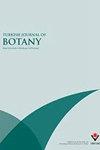The effect of grafting on pollen fertility and seed production of diploid interspecific hybrid and tetraploid eggplant genotypes
IF 1.5
4区 生物学
Q3 PLANT SCIENCES
引用次数: 0
Abstract
: Solanum melongena is susceptible to diverse diseases and parasites, in particular the wilts (bacterial, Fusarium and Verticillium ), nematodes, and some insects. Solanum torvum is robust to Verticillium and some bacterial wilts and root-knot nematode. It was reported that interspecific hybrid plants originated out of the hybridization of these species were sterile. In our previous studies that have been carried out to overcome this interspecific hybridization barrier, only from Faselis F 1 that was used as the female parent, many interspecific hybrid seeds were obtained and 9.07% of the seeds grew into plants in vitro. The percentage of pollen viability and germination of tetraploid interspecific hybrid (amphidiploid) genotypes that have been produced by in vitro colchicine treatment, were 6.8 and 3.4 fold of its source diploid genotype, respectively. However, the increment was not high enough to overcome the interspecific hybridization barrier between S. torvum and S. melongena . In this study, the changes in pollen fertility of diploid interspecific hybrids and tetraploid plants, which have grafted on Pala or Faselis F 1 , were investigated. Pollen viability and germination percentage in diploid genotypes were not affected by grafting, although they increased significantly (51.54% and 119.73%, respectively) in tetraploid genotypes by grafting. It was determined that the fertile diploid rootstock used for the tetraploid genotypes that produced by chromosome doubling from cultured eggplants could increase the number of seeds per fruit. It was concluded that some fertile diploid varieties can be used as rootstocks in order to increase pollen viability, germination rate and seed yield of tetraploid genotypes with low pollen yield obtained from cultivated eggplant by chromosome doubling.嫁接对二倍体种间杂交和四倍体茄子花粉育性和种子产量的影响
:龙葵易患多种疾病和寄生虫,特别是枯萎病(细菌、镰刀菌和黄萎病)、线虫和一些昆虫。torvum对黄萎病菌、部分细菌性萎蔫菌和根结线虫有较强的抗性。据报道,由这些物种杂交产生的种间杂交植物是不育的。在我们以往克服这一种间杂交障碍的研究中,仅以Faselis f1为母本,获得了较多的种间杂交种子,离体成株率为9.07%。秋水仙碱离体处理产生的四倍体种间杂交(双二倍体)的花粉活力和发芽率分别是其源二倍体基因型的6.8倍和3.4倍。但是,其增加量不足以克服托尔维姆与黑绒球菌的种间杂交屏障。本研究研究了嫁接到Pala或Faselis f1上的二倍体种间杂种和四倍体植株的花粉育性变化。嫁接对二倍体基因型的花粉活力和发芽率无显著影响,而对四倍体基因型的花粉活力和发芽率有显著提高(分别为51.54%和119.73%)。利用培养的茄子染色体加倍产生的四倍体基因型,利用可育的二倍体砧木可以增加单果的种子数。结果表明,利用染色体加倍技术提高低花粉产量的四倍体基因型的花粉活力、发芽率和种子产量,可以利用一些可育的二倍体品种作为砧木。
本文章由计算机程序翻译,如有差异,请以英文原文为准。
求助全文
约1分钟内获得全文
求助全文
来源期刊

Turkish Journal of Botany
PLANT SCIENCES-
CiteScore
2.90
自引率
5.60%
发文量
31
审稿时长
6-12 weeks
期刊介绍:
The Turkish Journal of Botany is published electronically 6 times a year by the Scientific and Technological Research Council of Turkey (TÜBİTAK) and accepts manuscripts (in English) covering all areas of plant biology (including genetics, evolution, systematics, structure, function, development, diversity, conservation biology, biogeography, paleobotany, ontogeny, functional morphology, ecology, reproductive biology, and pollination biology), all levels of organisation (molecular to ecosystem), and all plant groups and allied organisms (algae, fungi, and lichens). Authors are required to frame their research questions and discuss their results in terms of major questions in plant biology. In general, papers that are too narrowly focused, purely descriptive, or broad surveys, or that contain only preliminary data or natural history, will not be considered (*).
The following types of article will be considered:
1. Research articles: Original research in various fields of botany will be evaluated as research articles.
2. Research notes: These include articles such as preliminary notes on a study or manuscripts on the morphological, anatomical, cytological, physiological, biochemical, and other properties of plant, algae, lichen and fungi species.
3. Reviews: Reviews of recent developments, improvements, discoveries, and ideas in various fields of botany.
4. Letters to the editor: These include opinions, comments relating to the publishing policy of the Turkish Journal of Botany, news, and suggestions. Letters should not exceed one journal page.
(*) 1. Raw floristic lists (of algae, lichens, fungi, or plants), species descriptions, chorological studies, and plant sociology studies without any additional independent approaches.
2. Comparative morphology and anatomy studies (that do not cover a family, tribe, subtribe, genus, subgenus, section, subsection, or species complexes with taxonomical problems) without one or more independent additional approaches such as phylogenetical, micromorphological, chromosomal and anatomical analyses.
3. Revisions of family, tribe, genus, subgenus, section, subsection, or species complexes without any original outputs such as taxonomical status changes, IUCN categories, and phenological and ecological analyses.
4. New taxa of all plants without any additional independent approaches such as phylogenetical, ecological, chromosomal, chorological and correlational analyses in addition to a detailed macro- and micro-morphological descriptions with quality field and microscopic illustrations of taxonomically important structures and identification key in the taxonomic group.
New records of all plants without any additional independent approaches such as phylogenetical, ecological, chromosomal, chorological and correlational analyses in addition to a detailed macro- and micro-morphological descriptions with quality field and microscopic illustrations of taxonomically important structures and identification key in the taxonomic group may be accepted for peer review if they contain 3 or more new records or taxonomical status update, such as lectotypification, new combinations, transfers, revivals and synonyms.
5. New taxa of algae, lichens, and fungi without any additional independent approaches such as phylogenetical, ecological, chromosomal, chorological and correlational analyses in addition to a detailed macro- and micro-morphological descriptions with quality field and microscopic illustrations of taxonomically important structures and identification key in the taxonomic group.
New records of algae, lichens, and fungi without any additional independent approaches such as phylogenetical, ecological, chromosomal, chorological and correlational analyses in addition to a detailed macro- and micro-morphological descriptions with quality field and microscopic illustrations of taxonomically important structures and identification key in the taxonomic group may be accepted for peer review if they contain 5 or more new records or taxonomical status update, such as lectotypification, new combinations, transfers, revivals and synonyms.
 求助内容:
求助内容: 应助结果提醒方式:
应助结果提醒方式:


